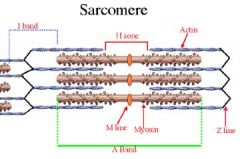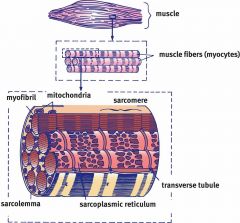![]()
![]()
![]()
Use LEFT and RIGHT arrow keys to navigate between flashcards;
Use UP and DOWN arrow keys to flip the card;
H to show hint;
A reads text to speech;
21 Cards in this Set
- Front
- Back
- 3rd side (hint)
|
What are the three types of muscles? |
i. Skeletal ii. Smooth iii. Cardiac |
|
|
|
Describe some properties of skeletal muscle. |
i. Under voluntary control (somatic nervous system) ii. Functional units are sarcomeres which are composed of actin and myosin filaments iii. Striated iv. Multinucleated v. Red fibers - mitochondrion rich, high myoglobin content (reddish), slow twitch fibers vi. White fibers - low mitochondrion amount, low myoglobin content, fast twitch fibers vi. Requires Ca2+ for contraction |
|
|
|
Describe some properties of smooth muscle. |
i. Under control of automatic nervous system
ii. No striations iii. Myogenic activity: does not need neural input to contract iv. Uninucleated v. Requires Ca2+ for contraction |
|
|
|
What is tonus? |
Constant low level contraction (as seen in blood vessels)
|
|
|
|
Describe some properties of cardiac muscle. |
i. mostly uninucleated, may contain 2 nuclei ii. striated iii. myogenic activity iv. cells are connected via intercalated disc that contain many gap junctions: allows simultaneous depolarization so that everything contracts at the same time. v. Requires Ca2+ for contraction |
|
|
|
What are the components of the sarcomere? |

Composed of thin (actin) and thick (myosin) filaments. i. A band: entire thick filaments, including overlap with thin filaments ii. Z bands: the ends of the sarcomere. From one Z band to the next defines the length of the sarcomere. iii. M band: middle of the sarcomere iv. I band: only thin filaments v. H band: only thick filaments |
Z - the end of alphabet M - for middle I - i is a thin letter H - H is a thick letter A - all of the thick, including any overlapping |
|
|
As the sarcomere contracts, which bands become smaller, and which one remains the same? |
All the bands (I, H, distance between Z lines, distance between M lines) become smaller, except for the A band. |
|
|
|
What proteins cover the actin on the thin filaments? What are their roles? |
Tropomyosin, and troponin. Tropomyosin covers the binding site for myosin heads to bind to the actin. Troponin binds to calcium, which results into a conformational change in tropomyosin, and exposes the actin binding site. The myosin heads are able to bind to the actin. |
|
|
|
What do many sarcomeres form?
|

Myofibrils |
|
|
|
What are myofibrils surrounded by? What do they do? |
The sarcoplasmic reticulum, contain calcium. |
|
|
|
What is the cell membrane of a myocyte (collection of myofibrils)?
|
Sarcolemma which receives signals from efferent neurons that release acetylcholine to induce an action potential.
|
|
|
|
What are the transverse (T tubules)?
|
Used to distribute the action potential to all the sarcomeres. This causes the sarcoplasmic reticulum to release Ca which binds to troponin, causing a conformational shift in tropomyosin, and allowing myosin to bind to actin. |
|
|
|
Describe the structural hierarchy of muscle fibers.
|
Sarcomeres -> myofibrils -> muscle fiber (myocyte, muscle cell) -> muscle (from parallel muscle fibers) |
|
|
|
Describe the process of the shortening of sarcomeres through the sliding filament model. |
i. ATP is hydrolyzed to ADP and P cocking mysoin head. ii. myosin to bind to actin after Ca is bound to troponin. iii. As the ADP and P unbind from myosin, it causes a power stroke. iv. New ATP is bound to myosin which releases myosin from actin. |
|
|
|
How does relaxation occur?
|
Acetylcholinesterase breaks down acetylcholine, terminating the signal at the neuromuscular junction.
|
|
|
|
What kind of response do muscle cells exhibit, why?
|
All or nothing response, they either respond to a stimuli completely or they not at all. This is because action potentials work the same way. |
|
|
|
Describe the mechanism of a simple twitch. |
A simple twitch is a response to a single muscle fiber to a brief stimulus at or above threshold. Consists of: i. latent period: time between reaching threshold and onset of contraction ii. contraction period iii. relaxation period |
|
|
|
What is frequency summation? |

When a muscle fiber is exposed to frequent and prolonged stimulation it will have insufficient time to relax, this is known as tetanus. This causes muscle fatigue. |
|
|
|
How can ATP be regenerated? |
By using ADP and phosphate creating to create ATP and creatine. The reverse also occurs during time of rest.
|
|
|
|
Besides aerobic metabolism to generate ATP, what else can be used to produce ATP? |
Glycolysis and fermentation (lactic acid in humans). |
|
|
|
What is oxygen debt?
|
During strenuous activity, aerobic metabolism may not be able to keep up with the demands for ATP production due to insufficient oxygen levels. Thus red fibers will switch to anaerobic metabolism producing lactic acid. When lactic acid is converted back into pyruvate to enter the citric acid cycle, oxygen is required. This is the oxygen debt. The difference between the amount of oxygen needed by the muscles and the actual amount present. |
|

